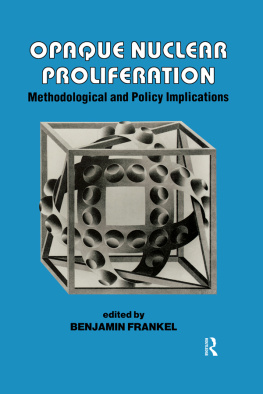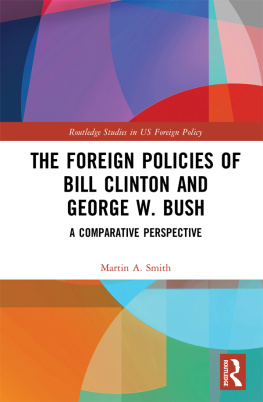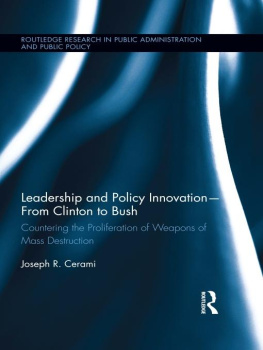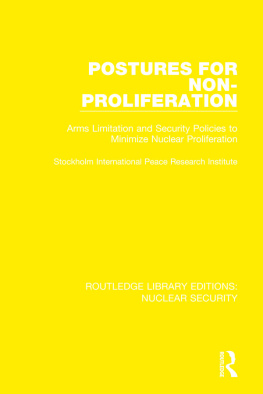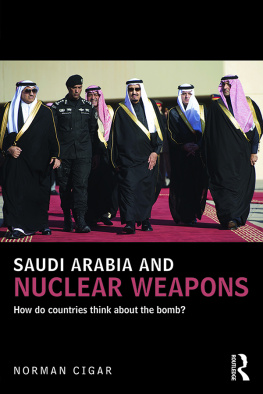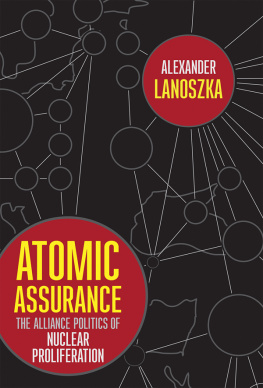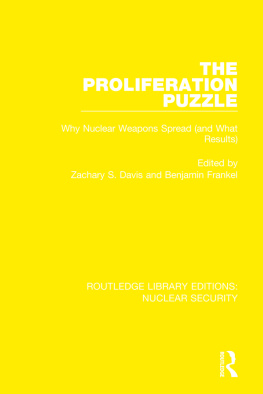First published 2001 by
FRANK CASS PUBLISHERS
Published 2013 by Routledge
2 Park Square, Milton Park, Abingdon, Oxon OX14 4RN
711 Third Avenue, New York, NY, 10017, USA
Routledge is an imprint of the Taylor & Francis Group, an informa business
Copyright of collection 2001 Frank Cass & Co. Ltd
Copyright of chapters 2001 contributors
British Library Cataloguing in Publication Data
Twenty-first century weapons proliferation: are we ready?
1. Arms race
I. Sokolski, Henry II. Ludes, James
355.82
Library of Congress Cataloging-in-Publication Data
Twenty-first century weapons proliferation: are we ready? / edited by Henry Sokolski and James M. Ludes; with a foreword by John J. Fialka.
p. cm.
Includes bibliographical references and index.
1. United StatesMilitary policy. 2. World politics21st century. 3. Weapons of mass destruction. 4. Nuclear nonproliferation. 5. Arms control. 6. Security, International. I. Sokolski, Henry. II. Ludes, James M.
UA23.T877 2001
355.033573dc21
00-065675
ISBN 13: 978-0-714-65095-1 (hbk)
ISBN 13: 978-0-714-68137-5 (pbk)
All rights reserved. No part of this publication may be reproduced, stored in or introduced into a retrieval system or transmitted in any form or by any means, electronic, mechanical, photocopying, recording or otherwise, without the prior written permission of the publisher of this book.
Perhaps the most spectacular, yet least remembered physical event of the twentieth century was called TEAK. It was a thermonuclear warhead detonated nearly 50 miles high over the Pacific by US nuclear weapons scientists on 1 August 1958. The explosion, at least 20 times more powerful than the atomic bomb that incinerated Nagasaki, produced an amazing show of light, heat, radiation and electronic effects. Some of them raged over the entire Pacific. Nothing like it had ever been seen before on Earth, and we should pray, think deeply and work hard so that nothing like it will be seen again.
The point of this book is that, as we open the glittery doorway into a new century, we should not forget the lessons of the recent past. It was visions of endless prosperity and hope for a rapidly civilizing world based on the electronic transfer of information that led us into the twentieth century. The visions were soon dashed by two ugly wars that unleashed the most powerful weapons that humanity has ever devised. Like it or not, these weapons are part of the burden we carry into the twenty-first.
Take TEAK, for example. To the scientists that sent it aloft, it had a terrible beauty. It started with an acetylene-like flash of bright light surrounded by an astonishing fireball that shot upward and outward. Within six minutes it was 600 miles in diameter, a death star burning in the ionosphere. It could be seen in Hawaii, over 700 miles away. As the nations first unclassified primer of the nuclear age, a 700-page US Army manual called The Effects of Nuclear Weapons, noted in 1962, TEAK rose to a height of 90 miles and it was surrounded by a luminous red ring. It was apparently caused by shock waves ripping through the thin air at the edge of the Earths atmosphere. A brilliant aurora appeared from the bottom of the fireball, and purple streamers were seen to spread toward the north. They could be seen from the Samoan Islands, more than 2,000 miles away. While TEAK produced the most stunning fireworks display ever seen, the scientists were interested in effects that could not be seen. One of them was a force called electromagnetic pulse, a raging storm of electrons spreading at 2,000 miles per hour. It knocked out radio communications over much of the Pacific. In some areas, the blackout lasted as long as ten hours.
As you will learn from reading this collection of essays, the number of nations pondering the effects, both physical and political, of nuclear weapons is spreading. One of the ways these weapons might be used against a prosperous nation that is heavily dependent on electronic gear and space-based communications (such as the USA) would be to launch another shot like TEAK. It could be a twenty-first century Pearl Harbor a bold stroke that leaves a prospective enemy blind and dumb at the moment of attack. Unthinkable, you might be tempted to say. But US and Russian scientists spent decades weighing the pros and cons of attacks like this. Now others, from Baghdad to Pyongyang to Beijing, are avidly studying the arts of this kind of war. One of the most poorly understood lessons of our recent past is that putting hard problems into the memory hole marked unthinkable, or papering them over with diplomatic controls that do not work, may be politically expedient, but in the final summation are downright dangerous. Such exercises in wishful or non-thinking led directly to the buildup of German and Japanese forces that introduced us to the prolonged campaign of terror, pain, expense and death that was the Second World War.
The few books we have about nuclear proliferation are often hand-wringing, jargon-laden affairs, written for a small group of technical and military cognoscenti people who often seem incapable of getting the attention of a larger audience. This book tries to broaden the message. One writer even puts his finger on the communications problem. The gurus of anti-terrorism, says David C. Rapoport, feel tempted to exaggerate potential threats to enhance their careers. That way, whatever happens, they will not have understated the problem. In the meantime, however, they have frightened the politicians and the defense planners the very people they need to reach. Exaggerating the risks and costs that must be met, as Rapoport notes, is like urging the purchase of a huge insurance policy with someone elses money. Instinctively, all but the most courageous policy makers flee such scenarios, preferring to spend their time and money working on easier problems that give more obvious and immediate benefits to constituents.
This book tells us that the problems of proliferating nuclear states and terrorist groups that possess weapons of mass destruction are threats that loom in the near future. They are threats that are certainly thinkable and probably solvable if we have the time and the patience and if we apply the resources necessary to do the work. We know that stuffing things like TEAK down the memory hole will not make them go away. Simply setting our collective hair on fire with worst-case visions is not the answer, either.
Thomas G. Mahnken notes that the scenarios of the gurus are so powerful that the US military has fought mightily not to engage its thinkers in this area. How do they do that? Well, he says, they avoid dealing with potentially embarrassing tactics such as a surprise nuclear attack using the effects of electromagnetic pulse or the use of chemical weapons on forward military bases by simply not putting them in war games. That makes it easier for players to look good a major objective of the modern military. While their generals and admirals may indulge in such ostrich-like strategies, industrial nations have nonetheless developed powerful weapons that can be used to lure emerging powers away from the ugly arsenals that some of them are contemplating. These are democracy, booming economies and border-penetrating communications that show, as West Germany showed East Germany, that a nation that has only a grim war footing to hold it together will have a decidedly grim future.





